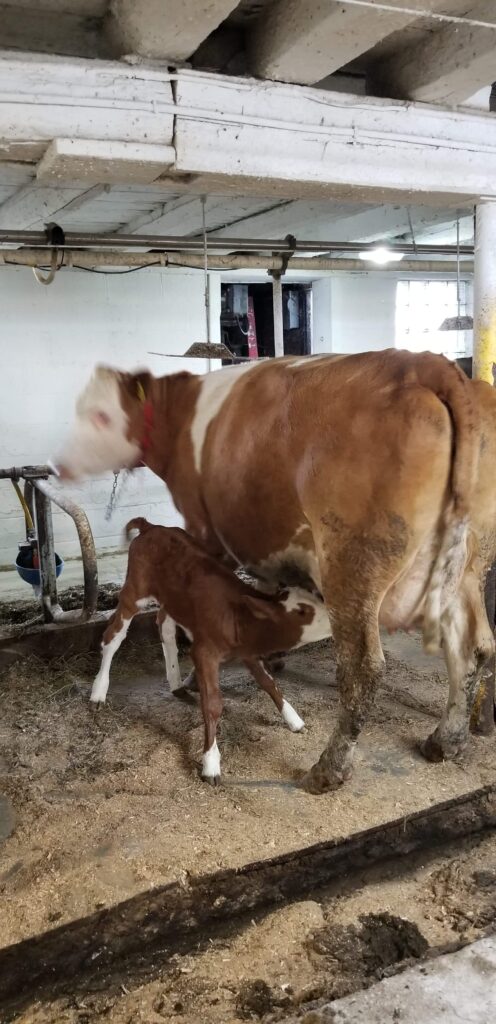Robotic milking/milking machine analysis and Fleckvieh udder conformation
Let us not forget mother nature in our modern dairy farms! The nursing on the cow needs to be duplicated to cause hormonal mechanisms to cause milk let down and the teat and teat ends are protected as though a calf was nursing.

As there are more and more farms starting to use robots to milk cows, it is critical to make sure that the cows visiting the robots have udders to best match the equipment. Within the sire selection process, Bavarian Fleckvieh genetics (www.bayerngenetik.de) are carefully chosen to match the needs of each farm. Offered up sires can be seen under “Order Fleckvieh Semen” on this site. Read on to see udders as one part of the equation and equipment as the other part.
COW UDDER CONFORMATION AND GENETICS:
To get full benefit of the below info – please set aside an hour to watch this. Sire selection with Fleckvieh sires whether you are using three way cross, first cross or pure breeding – we can assist in building the best outcome for your farm with over 30 years of Veterinary and Animal Science/nutrition expertise!
Only highly screened and proven genetics can give you consistent results as sourced from www.bayerngenetik.de and available here in North America.
IN depth look at udder conformation and importance of good ligaments:
Credit to the Canadian Veterinary Medical Association and Dr. Gordon Atkins for this analysis and insight into what it takes to suite cows to a robotic milking system:
EQUIPMENT
If you are questioning your cow herd`s performance (e.g. somatic cell counts) – do not overlook the robots and try to “fix” only the cows. There is a veterinary consultant that I have listed below for your consultation :
The website is www.mitchellvets.ca – Dr. Phil Meadows is the contact person at [email protected] phone number (519-348-9711)
ASK yourself:
Do you have high SCC results or too much mastitis?
Do you have high bulk tank Bactoscan results?
Do you want to milk cows faster?
Do you have cows that won’t go into the parlor very well, kicking, uneasy during milking?
Phil can help as he explains below in more detail:
“I have successfully completed several milk equipment analysis workshops and programs including the Boumatic Milking School (Madison Wisconsin), American Association of Bovine Practitioners (AABP) pre-conference Milk Quality Workshop (Montreal), Dr. Dave Reid’s milking equipment analysis workshop (St.Mary’s area farms), National Mastitis Council (NMC) pre- conference milking inflation workshop (Arizona) and the University of Guelph Dairy Health Management Certificate program Module 4 and 5 – Milk Quality and Udder Health.
I have the required vacuum recording equipment to carry out the full NMC testing analysis (VaDia, Triscan, airflow meter, vacuum gauge, teat cup plugs, etc.) on any type of milking equipment including robots!”
An independent set of eyes to “See Milk Quality Differently”:
- ✓ 10 years of experience with milk equipment analysis.
- ✓ Thorough examination of facilities to assess mastitis and milk quality risk.
- ✓ Milking time equipment analysis (NMC testing Protocol).
- ✓ Milking management analysis – udder prep routine, teat scores after units come off, unit alignment scores, parlour cow flow, etc.
- ✓ Milk equipment NMC dry testing (pulsator function, vacuum reserve, fall-off test).
- ✓ Teat End Scoring of the milking herd.
- ✓ Data analysis: DHI, DFO and parlour/robot software. I take a team approach with the following steps: attend a milking, gather the information/data and create a report with recommendations. Then I organize a meeting within 2 weeks of my milking time visit to review my report. The people at this meeting include the owner, herd veterinarian, milk equipment rep., nutritionist (if interested) and any other people the owner wants to have at the meeting. The goal of this meeting is to create an action list that includes what the team agrees to do, who is going to do it and when it is going to be completed. I follow- up with the owner and herd vet within 1 to 2 months for feedback on the progress. I look forward to the opportunity of partnering with you and your clients to “See Milk Quality Differently” for improved milk quality and production!